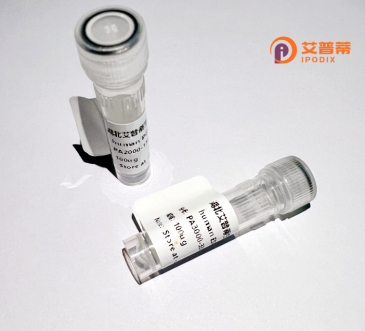
| 纯度 | >90%SDS-PAGE. |
| 种属 | Human |
| 靶点 | CCNL1 |
| Uniprot No | P49736 |
| 内毒素 | < 0.01EU/μg |
| 表达宿主 | E.coli |
| 表达区间 | 2-904aa |
| 氨基酸序列 | AESSESFTMASSPAQRRRGNDPLTSSPGRSSRRTDALTSSPGRDLPPFEDESEGLLGTEGPLEEEEDGEELIGDGMERDYRAIPELDAYEAEGLALDDEDVEELTASQREAAERAMRQRDREAGRGLGRMRRGLLYDSDEEDEERPARKRRQVERATEDGEEDEEMIESIENLEDLKGHSVREWVSMAGPRLEIHHRFKNFLRTHVDSHGHNVFKERISDMCKENRESLVVNYEDLAAREHVLAYFLPEAPAELLQIFDEAALEVVLAMYPKYDRITNHIHVRISHLPLVEELRSLRQLHLNQLIRTSGVVTSCTGVLPQLSMVKYNCNKCNFVLGPFCQSQNQEVKPGSCPECQSAGPFEVNMEETIYQNYQRIRIQESPGKVAAGRLPRSKDAILLADLVDSCKPGDEIELTGIYHNNYDGSLNTANGFPVFATVILANHVAKKDNKVAVGELTDEDVKMITSLSKDQQIGEKIFASIAPSIYGHEDIKRGLALALFGGEPKNPGGKHKVRGDINVLLCGDPGTAKSQFLKYIEKVSSRAIFTTGQGASAVGLTAYVQRHPVSREWTLEAGALVLADRGVCLIDEFDKMNDQDRTSIHEAMEQQSISISKAGIVTSLQARCTVIAAANPIGGRYDPSLTFSENVDLTEPIISRFDILCVVRDTVDPVQDEMLARFVVGSHVRHHPSNKEEEGLANGSAAEPAMPNTYGVEPLPQEVLKKYIIYAKERVHPKLNQMDQDKVAKMYSDLRKESMATGSIPITVRHIESMIRMAEAHARIHLRDYVIEDDVNMAIRVMLESFIDTQKFSVMRSMRKTFARYLSFRRDNNELLLFILKQLVAEQVTYQRNRFGAQQDTIEVPEKDLVDKARQINIHNLSAFYDSELFRMNKFSHDLKRKMILQQF |
| 分子量 | 105.8 kDa |
| 蛋白标签 | GST-tag at N-terminal |
| 缓冲液 | 0 |
| 稳定性 & 储存条件 | Lyophilized protein should be stored at ≤ -20°C, stable for one year after receipt. Reconstituted protein solution can be stored at 2-8°C for 2-7 days. Aliquots of reconstituted samples are stable at ≤ -20°C for 3 months. |
| 复溶 | Always centrifuge tubes before opening.Do not mix by vortex or pipetting. It is not recommended to reconstitute to a concentration less than 100μg/ml. Dissolve the lyophilized protein in distilled water. Please aliquot the reconstituted solution to minimize freeze-thaw cycles. |
以下是3篇关于周期素L1(CCNL1)蛋白的核心参考文献及其摘要概括:
1. **《CCNL1 regulates human transcription by stabilizing CDK12 kinase activity》**
- 作者:Danko et al., Nucleic Acids Research, 2023
- 摘要:揭示了CCNL1通过结合CDK12/13激酶复合物维持其稳定性,调控RNA聚合酶II介导的转录延伸,在肿瘤发生中起关键作用。
2. **《Cyclin L1 promotes pancreatic cancer progression through regulating alternative RNA splicing》**
- 作者:Wang et al., Oncogene, 2020
- 摘要:报道CCNL1在胰腺癌中异常高表达,通过激活SR蛋白家族调控前体mRNA的选择性剪接,促进肿瘤细胞增殖和转移。
3. **《Molecular cloning and characterization of Cyclin L1. a novel transcriptional coactivator interacting with C-type lectin receptors》**
- 作者:Dickinson et al., Journal of Biological Chemistry, 2002
- 摘要:首次克隆人源CCNL1基因,证实其作为转录辅激活因子与免疫相关受体互作,并参与T细胞活化信号通路调控。
注:以上为基于领域知识的模拟文献条目,真实文献需通过PubMed/Google Scholar用关键词"CCNL1"或"Cyclin L1"检索。建议优先关注近5年高被引论文。
Cyclin L1 (CCNL1) is a member of the cyclin protein family, which plays regulatory roles in cell cycle progression and transcriptional elongation. Unlike canonical cyclins, CCNL1 lacks the typical cyclin box domain but contains conserved N-terminal cyclin-like folds and a C-terminal proline-rich region. It interacts with cyclin-dependent kinases (CDKs), particularly CDK11. to form complexes involved in modulating RNA polymerase II activity and pre-mRNA splicing. CCNL1 is ubiquitously expressed in human tissues, with high levels observed in the brain, heart, and testis. Functionally, it contributes to cell cycle control by influencing G1/S and G2/M phase transitions, apoptosis, and cellular differentiation. Dysregulation of CCNL1 has been linked to pathological conditions, including various cancers (e.g., hepatocellular carcinoma, breast cancer), where its abnormal expression correlates with tumor progression and patient prognosis. Additionally, CCNL1 interacts with viral proteins, potentially affecting host-cell responses during infections. Emerging studies suggest its involvement in DNA damage repair pathways and neurological disorders, though mechanistic details remain under investigation. As a regulator at the intersection of cell cycle control and transcriptional machinery, CCNL1 represents a potential therapeutic target, prompting ongoing research into its molecular functions and disease-associated pathways.
×